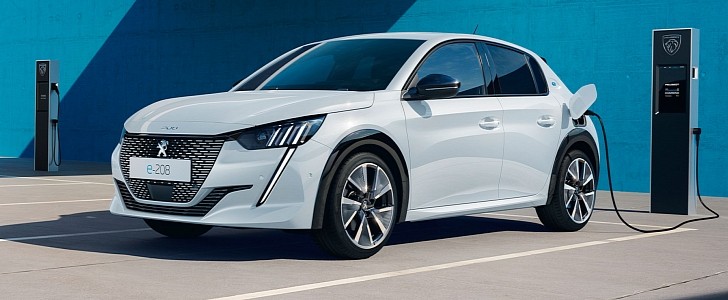Redesigned in 2019, the Peugeot 208 has an electric sibling twinned with subcompact hatchbacks and crossovers from Citroen, Opel, and DS. Following a small optimization at the end of 2021, the French automaker’s smallest electric vehicle has received a well-deserved boost in power and range for the upcoming model year. First and foremost, power increases by 15 percent, from 134 hp (136 ps) to 154 hp (156 ps).
The front-mounted electric motor comes from the recently unveiled e-308. The Lion of Sochaux has also reduced average energy consumption to 12 kWh per 100 kilometers (62 miles per hour). Range has increased by 10.5 percent or 38 kilometers (23.6 miles) to 400 kilometers (248.5 miles).
As expected, these updates wouldn’t have been possible without a different battery. Now sporting a gross capacity of 51 kWh, the lithium-ion pack features a usable capacity of 48.1 kWh and operates at 400 volts. Expected to arrive on the market in 2023, the latest iteration of the Peugeot e-208 produces 191 pound-foot (260 Nm), just like the current model year.
We don’t know if Peugeot has also improved acceleration performance, but chances are that it did. The additional ponies are delivered from zero kilometers per hour, which should help the 2023 model accelerate from zero to 100 kilometers per hour (62 miles per hour) in less than 8 seconds.
The latest iteration carries over all the benefits introduced for 2022. The highlight comes in the guise of a heat pump, which preserves charge when using the climate control with the help of a humidity sensor on the windshield. Low-resistance tires wrapped around 16-inch wheels also need to be mentioned, along with an efficiency-oriented transmission ratio.
A 7.4-kW onboard charger is standard, just like before. Prospective customers are offered an optional 11-kW onboard charger for quicker charging. As for direct-current charging at 100 kW, the French automaker says that 20 to 80 percent battery charge is possible in less than 25 minutes.
As expected, these updates wouldn’t have been possible without a different battery. Now sporting a gross capacity of 51 kWh, the lithium-ion pack features a usable capacity of 48.1 kWh and operates at 400 volts. Expected to arrive on the market in 2023, the latest iteration of the Peugeot e-208 produces 191 pound-foot (260 Nm), just like the current model year.
We don’t know if Peugeot has also improved acceleration performance, but chances are that it did. The additional ponies are delivered from zero kilometers per hour, which should help the 2023 model accelerate from zero to 100 kilometers per hour (62 miles per hour) in less than 8 seconds.
The latest iteration carries over all the benefits introduced for 2022. The highlight comes in the guise of a heat pump, which preserves charge when using the climate control with the help of a humidity sensor on the windshield. Low-resistance tires wrapped around 16-inch wheels also need to be mentioned, along with an efficiency-oriented transmission ratio.
A 7.4-kW onboard charger is standard, just like before. Prospective customers are offered an optional 11-kW onboard charger for quicker charging. As for direct-current charging at 100 kW, the French automaker says that 20 to 80 percent battery charge is possible in less than 25 minutes.






